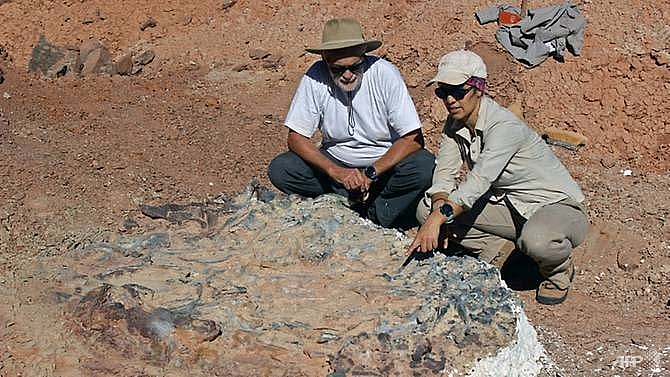Scientists unearth 220 million-year-old dinosaur fossils in Argentina
 |
| Scientists speculate the site was a former drinking hole at a time of great drought, where the creatures died of weakness AFP/HO |
"There are almost ten different individuals, it's a mass of bones, there's practically no sediment," said Argentinian paleontologist Ricardo Martinez.
"It's very impressive."
According to Martinez, of the University of San Juan, the fossils are approximately 220 million years old, belonging to "an era of which we know little".
"This discovery is doubly important because there are at least seven or eight individuals of dicynodonts, the ancestors of mammals, the size of an ox," he said.
He said there were also remains of archosaurs, reptiles that could be the ancestors of great crocodiles "that we do not know about yet".
The find was discovered in September last year in San Juan province, about 1,100km west of Buenos Aires.
The site is between one and two metres in diameter and about the same depth, leading scientists to speculate it was a former drinking hole at a time of great drought, and the creatures died of weakness at the spot.
Argentina has been a rich source of fossils from the Triassic, Jurassic and Cretaceous eras over the years - most, of creatures not found in the northern hemisphere.
What the stars mean:
★ Poor ★ ★ Promising ★★★ Good ★★★★ Very good ★★★★★ Exceptional
Related Contents
Latest News
More News
- Tropical storm Trami leaves at least 24 people dead in Philippines (October 24, 2024 | 17:36)
- Singapore grants conditional approval for solar power import from Australia (October 24, 2024 | 17:27)
- ASEAN digital economy set to reach $2 trillion by 2030 (October 22, 2024 | 15:08)
- Thailand asks Laos to waive visa fee at border checkpoints to boost tourism (October 21, 2024 | 17:23)
- Laos pledges to continue efforts to empower girls (October 21, 2024 | 17:17)
- Chinese electric vehicle maker to build plant in Indonesia (October 21, 2024 | 17:12)
- Vietnam Elevator Association introduces Elevator Safety Application to the world (October 18, 2024 | 09:00)
- A taste of the future - the go-to spot at the Worldchefs Congress & Expo 2024 (October 15, 2024 | 16:11)
- Jakarta to impose household waste levy (October 14, 2024 | 16:49)
- China, Laos plan to build connectivity development corridor with Thailand (October 14, 2024 | 16:19)



 Tag:
Tag:





















 Mobile Version
Mobile Version